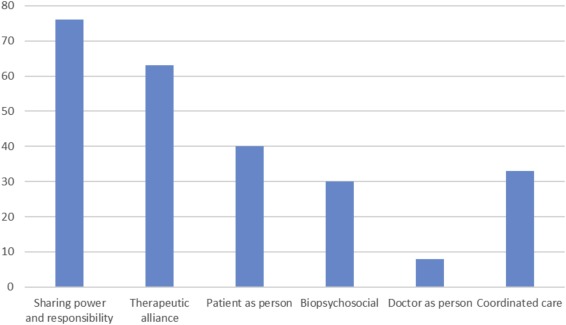I’ve been researching patient-centered care (PCC) for the last few years now both by observing its enactment (or lack thereof) in clinical practice and by reading the vast amount of literature on the topic. I sometimes feel that I’m drowning in a deep, dark, tumultuous ocean of never-ending articles on the topic. Despite the sheer volume of literature, in most articles I’ve read, the authors have confided that there is no clear definition of the term. It’s no wonder that readers can be confused! Even the librarian that helped me develop a search strategy for my PhD research admitted that PCC is a “fuzzy” topic!
Many articles that discuss PCC have varying ideas of what it entails. They describe the concept in vague terms like “considering patient preferences” and “including the patient in the decisions made about their healthcare.” But exactly what does that entail? In this post, I will discuss some of the seminal papers on the definition of PCC and hopefully shed some light on what PCC really involves. Please share your thoughts at the end!
The "fuzzy" definition of patient-centered care
So, I must admit that as I plodded through the hundreds of articles (and still counting!!!), I became despondent at the thought that my research would be difficult because of this lack of a clear definition. Concepts of the topic range from operational, to moral and ethical, to philosophical, and are authored by healthcare providers, researchers, educators, organizational managers, and philosophers. The topic spans fields from nursing, to medicine, to healthcare organization, public health policy, law, psychology, ethics and philosophy. Did I mention that it’s no wonder that readers can be confused? 😩
PCC has also been referred to as person-centered care,1 relationship-centered care,2 family-centered care, client-centered care3 and patient-focused care.4 I’m sure there are more out there, but these are the ones that have appeared frequently in my searches. PCC has also been described as a mode, a framework, a model, a method of working, and a philosophy, adding to the confusion about the topic.

The Picker Institute’s definition
There has been some progress towards a more standardized definition over the years. In 1987, the Picker Institute defined 8 principles of PCC.5 These included:
- Respect for patient’s needs, preferences, and values
- Co-ordinated and integrated care
- Clear, high-quality information and education
- Physical comfort
- Emotional support and alleviation of fear and anxiety
- Involvement of family and friends
- Continuity of care
- Access to care
Mead and Bower’s definition
In 2000, Mead and Bower, in a seminal text, reviewed the literature up until that time and determined five domains of PCC. They emphasized that PCC differs from the biomedical domain in these 5 dimensions that are based on the relationship between patient and provider:
- Sharing of power and responsibility: this is typically understood as shared decision-making where both patient and provider come to a mutually decided upon decision about the patient’s healthcare through the sharing of information and values in an egalitarian manner
- Therapeutic alliance: this focuses on building a relationship of trust and cooperation between patient and provider
- Biopsychosocial perspective: this involves broadening the provider’s perspective of the patient beyond the biomedical model to incorporate social and psychological aspects of the patient.
- Patient-as-person: this involves the patient’s current life situation and how she is affected by her illness. It encompasses the individuality of the patient and everything about her that leads to her life experience of her illness.
- Doctor-as-person: this refers to the mindset, mood and manner of the doctor, which can affect the relationship with her patient. Personally, I feel that this definition is lacking. There are so many more aspects of the provider that affect the clinical encounter, but I will discuss more about this in a future blog.
The Institute of Medicine’s definition
Then in 2001, the Institute of Medicine (IOM), in another seminal document titled “Crossing the Quality Chasm”6 written in response to concerns about patient safety in healthcare, called for a fundamental change in approach to patient care. Inspired by the Picker Institute’s definition, the IOM provided more operationalized definitions, and wrote from a health policy perspective. They proposed 6 dimensions that included:
- Respectfulness to patients’ values, preferences and expressed needs which encourages providers to approach the patient from a more holistic perspective and as the unique individual she is, rather from a standardized approach of the biomedical model
- Coordinated and integrated care which is particularly important for very vulnerable patients who are unable to coordinate their own care
- Provision of information, communication and education which is important to shared decision-making
- Ensuring physical comfort which is related to proper pain management and management of other forms of discomfort
- Providing emotional support, relieving fear and anxiety which can be a significant experience for patients who are in ill health
- Involving family and friends who can provide support and help with decision-making.
These dimensions are very similar to those proposed by the Picker Institute. It is possible that the Picker Institute’s dimensions of continuity of care and access to care can be collapsed into the IOM’s coordinated and integrated care category.
The updated domains of patient-centered care
The most comprehensive definition so far (in my opinion), and the most recent, built on Mead and Bower’s 5 domains. In 2019 Langberg et al7 conducted a systematic review of all the literature on PCC since Mead and Bower’s review. In their final definition, they kept all the dimensions from Mead and Bower, but added the domain of coordinated care as a sixth domain (see box). Langberg et al defined this domain as “the delivery of services by different care providers in a timely and complementary manner in order to achieve connected and cohesive patient care.” The goal of coordinated care in the context of PCC is to help reduce healthcare costs and make care more efficient and accessible. The domain seems to incorporate the dimensions of access to care and continuity of care from the Picker Institute, and that of coordinated and integrated care from the IOM.
An interesting tidbit
I think that the most interesting aspect that came from the review by Langberg et al, was that they determined the frequency with which each of their dimensions appeared in the literature (see graph below). Sharing of power and responsibility (mentioned in 76/80 articles) and the therapeutic alliance (mentioned in 63/80 articles) were the most frequently mentioned aspects of PCC in the literature. It’s no wonder that these are the domains which we typically associate with PCC!
What is even more interesting and telling in Langberg’s paper, is that the least mentioned dimension is that of the doctor-as-person. It was mentioned only in 7 of the 80 articles reviewed. Langberg et al surmise that this may be because the change in the health system towards more fragmented care, in addition to the development of guidelines and even evidence-based medicine (my thought here), reduced the role of the doctor’s personality and her individual characteristics. Langberg also states that this shift may also be due to a greater focus being placed on patient autonomy and patient needs.
While I definitely agree that these are likely possibilities for the lack of focus on the doctor-as-person dimension, I’d also like suggest a general lack of appreciation for the influence of the doctor’s personhood in healthcare. I think that many (not all!) healthcare providers lack a reflexive habit about their influence on their clinical practice and within the meeting with their patients. I tend to think that even in a fragmented health system, where the focus is more on patient autonomy, the clinical encounter is still a relationship between two people. Undoubtedly, one person influences the other through both verbal and non-verbal communication. Undoubtedly, there are two life worlds that are linked in the clinical encounter,8 where each individual influences the other. But this is fodder for another blog post!

Overarching themes of PCC
Langberg then proposed the following 3 components that encompass the 6 domains of patient-centered care:
- Understanding the patient situation
- Developing the doctor-patient relationship
- Managing coordination of care in the organizational system
However, I find these a bit vague. The 6 dimensions mentioned above give more guidance on this multidimensional concept and seem to me to be more useful when a provider is looking to implement PCC into practice in the clinic.
The philosophical concepts of patient-centered care
It is important to create a concrete definition of PCC in order to measure it in practice, especially as health systems move towards a more value-based approach. However, PCC is a multidimensional, latent construct that can also be understood from a philosophical perspective. This is my favourite lens through which to view PCC.
Loughlin9 describes PCC as an “ecological phenomenon” and states that human beings are organisms, which are whole at all of their stages of development. They are constantly in response to an ever-changing environment. They are not mechanisms, which is how current medicine, through the lens of the biomedical model, views the patient…the body as a machine.
Duggan2 takes a moral perspective. He uses consequentialist reasoning and states that PCC is only good once it leads to something good (a good consequence). Based on the empirical evidence that demonstrates positive outcomes, it is the right thing to do. A deontological perspective promotes a sense of obligation and duty. So from this perspective, PCC can be considered morally good because both the concepts of respect for persons and treatment of the person as a unique individual are embedded in the construct of PCC. Therefore, providers are obligated to use use this approach. Furthermore, in terms of virtue-based ethics, PCC can be considered morally right because it requires providers to self-reflect and to adopt those attitudes that positively influence patient care. This latter point is reflective of the doctor-as-person dimension.
Miles10 argues that PCC is an “anti-foundationalist” concept. Anti-foundationalism, in its simplest terms, states that there is no fundamental belief, or knowledge. Our knowledge is not for certain. This rejects the biomedical model that is based strictly the belief that scientific evidence is fact, and the only foundation of all our medical knowledge. Miles argues for the presence other types of knowledge sources in medicine, such as intuition, experience, and that obtained from patients about their beliefs, feelings, and desires. In a wonderfully eloquent statement, he argues that “medicine’s wide variety of knowledge sources should be able to form holistic webs in order to build and respond to a clinical picture or tapestry.”
Whew! That was a bit deep there for a bit!
So, as I’ve hopefully illustrated, PCC is a complex, multidimensional construct. It is not easy to define or understand. It seems that we understand it on the surface, but when we try to dig deeper into its core, it becomes increasingly difficult to operationalize, to measure, and to implement. I guess that this is a reason why there is so much research on it out there!
But in these attempts to define such a fuzzy, latent concept, we need to be careful to avoid just executing behaviours. Miciak11 cautions that PCC does not involve checking behaviors off a list, but rather, operating from a place of meaning. It is about the culture of the system. It is a way of thinking, being and doing. Indeed, a patient-centered provider is one who can adapt her behaviours to address the context of the patient and to what that patient needs from her at that time, instead of simply increasing the number of patient-centered behaviours she displays. It is this skill that this blog will hopefully help you to nurture.
While a patient will require different attributes of PCC at different times on his journey, we cannot separate one dimension from the next, or use them in isolation. Each dimension shapes the other, with a change in one dimension, affecting the expression or characteristics of the other.12 Patient-centered care is an evolutionary process that is dependent on the context at the time of the patient-provider interaction.
Fix13 says it best, stating that healthcare “will be truly patient-centered when It is not called patient-centered care, implying that PCC needs to be part of everyday life instead of something distinct.” For me, this is what resonates the most. What about you? I’m curious to hear your thoughts about the topic and about this post. Comment in the boxes below and let’s have a discussion!
Also, stay tuned for the upcoming series on the domains of PCC where I will elaborate and discuss each one. Join the journey into PCC below to make sure you don’t miss any!
Become a Better Healthcare Provider!
References
- Miles A, Asbridge JE. Clarifying the concepts, epistemology and lexicon of person-centeredness: an essential pre-requisite for the effective operationalization of PCH within modern healthcare systems. Eur J Pers Centered Healthc. 2014;2(1):1. doi:10.5750/ejpch.v2i1.857
- Duggan PS, Geller G, Cooper LA, Beach MC. The moral nature of patient-centeredness: Is it “just the right thing to do”? Patient Educ Couns. 2006;62(2):271-276. doi:10.1016/j.pec.2005.08.001
- Karstensen JK, Kristensen HK. Client-centred practice in Scandinavian contexts: A critical discourse analysis. Scand J Occup Ther. 2021;28(1):46-62. doi:10.1080/11038128.2020.1769183
- Xanthos C. Delivering a patient-focused health service: The views of physicians in Barbados. Health Sociol Rev. 2007;16(3-4):263-278. doi:10.5172/hesr.2007.16.3-4.263
- Picker Institute’s Eight Principles of Person-Centered Care. National Center for Interprofessional Practice and Education. Published April 15, 2015. Accessed May 6, 2022. https://nexusipe.org/informing/resource-center/picker-institute%E2%80%99s-eight-principles-person-centered-care
- Committee on Quality of Health Care in America. Crossing the Quality Chasm: (317382004-001). Published online 2001. doi:10.1037/e317382004-001
- Langberg EM, Dyhr L, Davidsen AS. Development of the concept of patient-centredness – A systematic review. Patient Educ Couns. 2019;102(7):1228-1236. doi:10.1016/j.pec.2019.02.023
- Daluiso-King G, Hebron C. Is the biopsychosocial model in musculoskeletal physiotherapy adequate? An evolutionary concept analysis. Physiother Theory Pract. Published online 2020:1-17. doi:10.1080/09593985.2020.1765440
- Loughlin M. Person Centered Care: Advanced Philosophical Perspectives. Eur J Pers Centered Healthc. 2020;8(1):20-33.
- Miles A. Values-based or values-informed? A non-foundationalist argument for the more rational positioning of health care values within a person-centred clinical decision-making framework. Published online 2014:17.
- Miciak M, Mayan M, Brown C, Joyce AS, Gross DP. A framework for establishing connections in physiotherapy practice. Physiother Theory Pract. 2019;35(1):40-56. doi:10.1080/09593985.2018.1434707
- Oprea L. AN ANALYTIC REVIEW OF THE DOCTOR-PATIENT RELATIONSHIP (part II). Romanian J Bioeth. 2009;(3):12.
- Fix GM, VanDeusen Lukas EdD C, Bolton MPH MSW RE, et al. Patient-centred care is a way of doing things: How healthcare employees conceptualize patient-centred care. 300 Health Expect. 2018;21:300-307. doi:10.1111/hex.12615








7 thoughts on “The definition of patient-centered care: Are you confused?”
May I simply say what a relief to discover an individual who genuinely understands what they are talking about on the
net. You certainly realize how to bring an issue to light and make it
important. More and more people really need to read this and understand this side of
your story. I was surprised you are not more popular since you definitely have the gift.
Pingback: What does good shared decision-making look like? - carlarauseo.com
Pingback: The Therapeutic Alliance: An Exploration of an Under-rated Healing Agent - carlarauseo.com
Pingback: The Biopsychosocial model - overcoming old challenges, creating new concepts - carlarauseo.com
Pingback: The Indispensable Role of the Clinician in Person-centered care - carlarauseo.com
Pingback: What does it mean to treat our Patient as a Person?
Pingback: taking a patient's history - lessons from the qualitative interview - carlarauseo.com